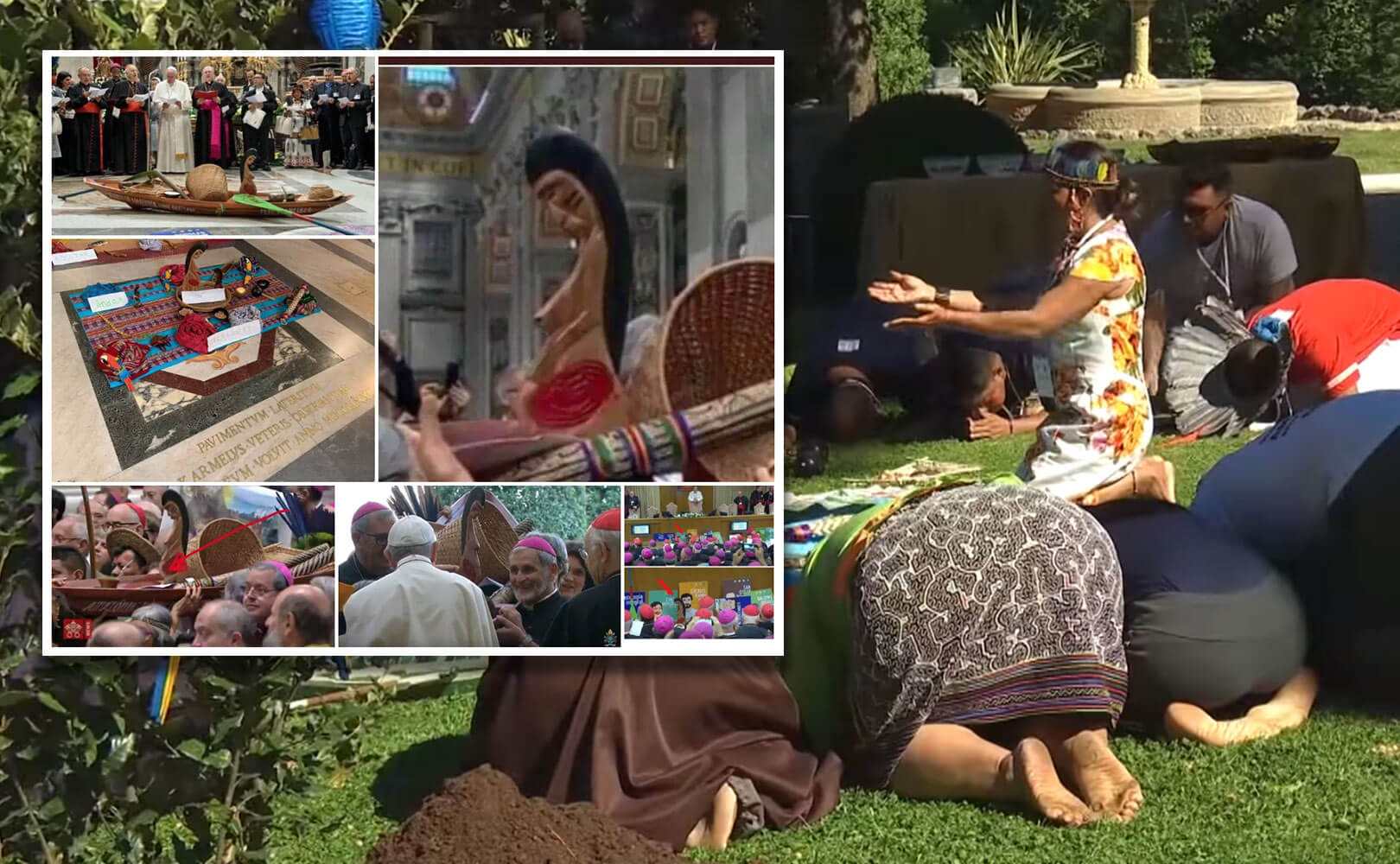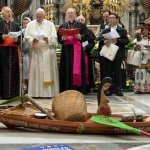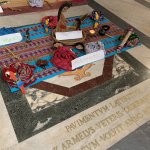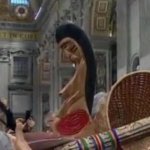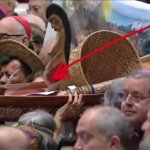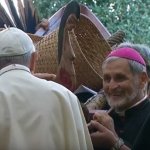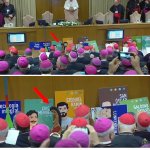At a ceremony in the Vatican gardens leading up to the Amazon Synod, a very strange ritual unfolded.
In addition to more ecological symbolism than you could shake a shrinking polar ice cap at, we saw some disturbing scenes, including a pair of naked pregnant statues carved from wood and a group of people, some in native garb, others in religious habits, bowing before them in what appeared to be an act of worship.
If you somehow missed it, some of the highlights can be seen in this news brief from Catholic News Service:
A number of Catholic commentators, myself included, observed at the time that whatever it was that was happening in the Vatican gardens, it looked very much like some sort of pagan idolatry.
Others insisted that this was some indigenous representation of the Visitation, or that at least one of the statues was of “Our Lady,” despite the obvious impropriety of presenting her totally naked and then bowing down before her in an act of obeisance that befits only God.
Austen Ivereigh, papal biographer, Crux associate editor, and Bergoglian sycophant extraordinaire, clearly hoped to have the Vatican affirm this obvious misrepresentation in the press conference on October 7 when he asked the members of the panel who were from the Amazon region the following question:
Some American media interpreted the figure of the pregnant woman as a pagan symbol of fertility. So I think it would be interesting to listen to your own opinions concerning about the topic of inculturation and respect for the values of the Amazonian tradition. So how do you interpret this image, that was a very strong image, the woman, the Amazonian woman, so how is she, this indigenous figure, considered? And what is the connection with the synod?
He did not exactly get the answer he was looking for. “I did not perceive,” said Bishop David Martínez de Aguirre Guinea of Peru, “this identification[.] … I’d seen this image on various occasions and I did not identify and not even and no one either at the vicarate … it was an image that was shown also on other occasions, and I wouldn’t know how to interpret it. Well, we all have our own interpretations … the Virgin Mary, the Mother Earth, probably those who used this symbol demonstrated, wishes to reflect fertility, to women, to life, the life presence among these Amazonian people … and Amazonia is meant to be full of life. I don’t think we need to create any connections with the Virgin Mary or with a pagan element.”
You can watch the exchange here:
At #SinodoAmazonico Presser, @austeni asks about the image of the naked pregnant woman used at Synod; an Amazon missionary Bishop says it probably represents "fertility, woman, life" adding we "don't need to create any connections with the Virgin Mary or with a pagan element" pic.twitter.com/PHefa8Fjra
— Catholic Sat (@CatholicSat) October 7, 2019
The speculation didn’t stop there. Articles were written trying to shoehorn the image into a motif of the Virgin Mary anyway.
An Italian site called “Antro Magia,” authored by a self-described pagan dedicated to “news on the world of esotericism, paganism or wicca” and covering “topics such as the occult, paranormal, legends and much more” claimed that the ritual was, as they admitted that the Twitter account CatholicSat explained, “a pagan fertility ritual, ‘with indigenous leaders who worshiped two idols of a fertility goddess of the Earth.'”
“We of the Antro,” the author continues, “know that there will always be those who are against these beautiful initiatives, unfortunately, but for our part we are very happy with this event that will surely open the doors to a more open and rosy future for us pagans.”
The author goes on to claim that those who led the ritual were “shamans” and that the rituals performed had “nothing to do with the Catholic Church and are indeed intrinsically incompatible with traditional doctrine.” They saw special significance in the ritual planting of the tree from Assisi, and the dances in a circle around that tree, which were intended, according to the author’s citation of a reporter present at the ceremony, to “pay homage and then plant [the] holm oak, a sign of love towards mother earth.”
“Finally,” the author concludes, “an important step for the church towards the recognition of pagan religions and their importance. We witches can only be very happy!”
Meanwhile, the image — which many have identified with Pachamama, an Incan fertility goddess who appears to have become symbolic across the Amazon region as an image of Mother Earth and ecology — has been turning up all over Rome during the Synod:
Predictably, controversy has continued to ensue over the Vatican’s embrace of what appears to be quite literally the idol of a pagan goddess.
Today, the question about the image was asked again at yet another press conference. Once again, the answer — which came in part from Fr. Giacamo Costa, S.J. and in part from Paolo Ruffini, both communications employees of the Vatican — was that “it is an indigenous woman who brings life.” Fr. Costa continued, with apparent amusement — and what looked like incredulity on his face — “nobody said it was the Virgin Mary. I don’t know who might have said so.”
At #SinodoAmazonico #AmazonSynod Presser, on the naked pregnant statue which has featured prominently at this Synod, Fr. Giacomo Costa SJ, Secretary of the Information Commission says "it is an indigenous woman who brings life"; adding "nobody said it was the Virgin Mary" pic.twitter.com/Gk3ZSDDBnS
— Catholic Sat (@CatholicSat) October 16, 2019
In their article on this aspect of the presser, CNA offered a bit more context and detail than the above set of tweets:
When told “many people have said” the woman is a figure of the Virgin Mary, Costa added “‘many have said,’ okay, as you like, but I have never heard that.”
“There is nothing to know. It is an indigenous woman who represents life,” he stated, adding that his information commission will look for more information about it, but “it is a feminine figure” and is “neither pagan nor sacred.”
Paolo Ruffini, prefect of the Vatican communications dicastery, said Wednesday he sees the figure as “representing life.”
“Fundamentally, it represents life. And enough. I believe to try and see pagan symbols or to see… evil, it is not,” he said, adding that “it represents life through a woman.” He equated the image to that of a tree, saying “a tree is a sacred symbol.”
Ruffini said that interpretation is his personal opinion, and he was not speaking as the head of Vatican communications or synod communications.
He added that “We know that some things in history have many interpretations” and he would look for more information about the image and inform journalists about what he finds out.
Note that despite his intentional ambiguity, Ruffini here is echoing the words of the pagan website that placed great emphasis on the symbolism of a tree. His dodge of the pagan significance of these symbols is merely that: a dodge.
I don’t know about you, but I’ve never done this before a mere symbol:
Most of us save this kind of reverence for adoration of the Blessed Sacrament.
The apologists for this kind of thing have no shame, even in the face of the latest indication that the Pachamama-esque figure is, at best, a Rorschach test, allowing the viewer to project whatever “deity” he wants it to be (or not to be) onto the statue. Some continue to insist that it is the Virgin Mary — a laughable claim at best.
Others, like Ivereigh, who backed the claim just a few days ago that it was “Our Lady of the Amazon” are now saying this doesn’t necessarily mean she is the Blessed Virgin Mary. “Everything that is human that is not evil is of God,” he claimed, condemning attempts to “demonize the native culture of the Amazon” as the true scandal of the synod:
For those who have been blocked by @austeni, here are screenshots of his 'before' and 'after' comments, in relation to today's @Synod_va press briefing (specifically, @dianemontagna's request for clarity concerning the nude female #pagan statue): pic.twitter.com/OzZdyuXHYc
— Matt Gaspers (@MattGaspers) October 16, 2019
Where Ivereigh is concerned about “demonizing” indigenous culture, Catholics should be preoccupied with baptizing those who practice it. Writing at her blog yesterday, Catholic author Leila Miller referenced a homily given by a priest at her parish, which cited Sublimis Dei, an encyclical from Pope Paul III in 1537:
We, who, though unworthy, exercise on earth the power of our Lord and seek with all our might to bring those sheep of His flock who are outside into the fold committed to our charge, consider, however, that the Indians are truly men and that they are not only capable of understanding the Catholic Faith but, according to our information, they desire exceedingly to receive it. Desiring to provide ample remedy for these evils, We define and declare by these Our letters, or by any translation thereof signed by any notary public and sealed with the seal of any ecclesiastical dignitary, to which the same credit shall be given as to the originals, that, notwithstanding whatever may have been or may be said to the contrary, the said Indians and all other people who may later be discovered by Christians, are by no means to be deprived of their liberty or the possession of their property, even though they be outside the faith of Jesus Christ; and that they may and should, freely and legitimately, enjoy their liberty and the possession of their property; nor should they be in any way enslaved; should the contrary happen, it shall be null and have no effect.
By virtue of Our apostolic authority We define and declare by these present letters, or by any translation thereof signed by any notary public and sealed with the seal of any ecclesiastical dignitary, which shall thus command the same obedience as the originals, that the said Indians and other peoples should be converted to the faith of Jesus Christ by preaching the word of God and by the example of good and holy living. [emphasis added by Leila Miller]
It is particularly interesting to contrast the writing of Paul III with the thought of Bishop Erwin Kräutler, a key synod organizer and longtime resident of the Amazon region, who said last week that “the indigenous people do not understand celibacy. For them, at least those I have met … they cannot understand this thing that a man is not married, that he does not have a woman taking care of the house, of the home.”
Here’s Pope Paul III:
The enemy of the human race, who opposes all good deeds in order to bring men to destruction, beholding and envying this, invented a means never before heard of, by which he might hinder the preaching of God’s word of Salvation to the people: he inspired his satellites who, to please him, have not hesitated to publish abroad that the Indians of the West and the South, and other people of whom We have recent knowledge should be treated as dumb brutes created for our service, pretending that they are incapable of receiving the Catholic Faith.[emphasis added]
All the talk of xenophobia and racism from advocates of the synod, and this is what they really think: that the indigenous peoples of Amazonia are too stupid to live the authentic Catholic faith. Instead of teaching them to reverence the Eucharist, we join them in bowing to their “symbols,” while our pope, instead of instructing Catholics in the Faith, is alleged to have denied the divinity of Chris, and tells us that it is the “climate crisis” that is truly urgent, while hosting a synod decrying “ecological sins” and our need to confess them.
With the constant attention on promoting what I call “Gaia Church” over and above the salvation of souls, is it any wonder we’re having a discussion about pagan idolatry in the Vatican? The truth is, we’ve been worshiping at the altar of strange gods for years now. This may be more overt, but it’s difficult to see it as new.
This post has been updated.

